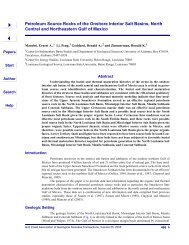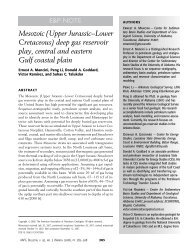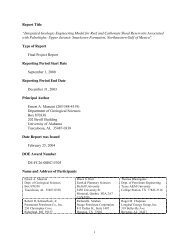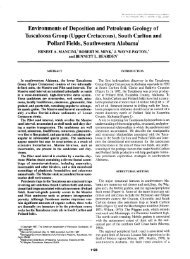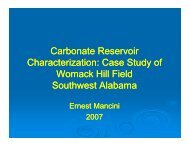Part 4 - Berg - Hughes Center
Part 4 - Berg - Hughes Center
Part 4 - Berg - Hughes Center
Create successful ePaper yourself
Turn your PDF publications into a flip-book with our unique Google optimized e-Paper software.
2.65-MMcf gas/day and 459 bbls of 45.8° API oil on an 11/64-inch choke, with a tubing<br />
pressure of 2,409 lb. and a gas/oil ratio of 5780 cf/bbl. Finally, in January 1966,<br />
commercial production in Black Lake field began after 24 years of drilling activity.<br />
Hermann (1971) mentions that after the successes of Black Lake field only minor<br />
production occurred in the Sligo in northern Louisiana.<br />
Lower Cretaceous Comanche/Trinity (Pine Island, James, Rodessa, Ferry Lake,<br />
Mooringsport)<br />
Pearsall Formation<br />
According to Forgotson (1963), the Pearsall Formation is the lowest of the units of<br />
the Lower Cretaceous Trinity Stage. In southern Arkansas, north Louisiana, and east<br />
Texas, it is subdivided, in ascending order, into the basal Pine Island Shale, the James<br />
(Cow Creek) Limestone, and the Bexar Shale. In Louisiana, these members are<br />
nearshore, sandy facies along the updip margin of deposition and cannot be subdivided.<br />
The Rodessa, Ferry Lake, and Mooringsport formations overlie the Pearsall. The Rodessa<br />
and Mooringsport comprise separate platform sequences. Anhydrite beds occur<br />
throughout the Rodessa. The Ferry Lake Anhydrite reflects a regional episode and is used<br />
as a marker bed throughout the northern Gulf (Petty, 1995; Montgomery et al., 2002).<br />
Pine Island Formation<br />
Producing Parishes<br />
Lincoln, Ouachita<br />
The Pine Island consists predominantly of calcareous black shale with interbedded<br />
fine-grained sandstone and minor crystalline limestone layers associated with lagoonal to<br />
nearshore marine environments. The widespread nature of the marine shales of the Pine<br />
Island is interpreted by Yurewicz et al. (1993) as regional transgressive deposits. The<br />
367




